10 Chapter 10: Pedigrees
Lisa Limeri; Shifath Bin Syed; Joshua Reid; and rocksher
Learning Objectives
By the end of this section, you will be able to do the following:
-
Based on the data in a pedigree, predict 1) whether the trait in question is autosomal or sex-linked and 2) which alleles are dominant and recessive.
-
On a pedigree, label 1) males and females, 2) affected and unaffected individuals, and 3) generations.
Introduction
Many human diseases are genetically inherited. A healthy person in a family in which some members suffer from a recessive genetic disorder may want to know if he or she has the disease-causing gene and what risk exists of passing the disorder on to his or her offspring. Of course, doing a test cross in humans is unethical and impractical. Instead, geneticists use pedigree analysis to study the inheritance pattern of human genetic diseases.
Pedigree Analysis
Pedigree charts show the phenotypes and/or genotypes of a particular organism and its ancestors. While commonly used in human families to track genetic diseases, they can be used for any species and inherited trait. Geneticists use standardized symbols to represent an individual’s sex, family relationships, and phenotype. These diagrams are used to determine the mode of inheritance of a particular disease or trait and to predict the probability of its appearance among offspring. Therefore, Pedigree analysis is an important tool in basic research and genetic counseling.
Each pedigree chart represents all available information about the inheritance of a single trait (most often a disease) within a family. The pedigree chart is therefore drawn using factual information. Still, there is always some possibility of errors in this information, especially when relying on family members’ recollections or even clinical diagnoses. In real pedigrees, further complications can arise due to incomplete penetrance (including the age of onset) and variable expressivity of disease alleles. Despite these real-world complications, for the examples presented in this book, we will assume complete accuracy of the pedigrees. A pedigree may be drawn when determining the nature of a newly discovered disease or when an individual with a family history of a disease wants to know the probability of passing the disease on to their children. In either case, a tree is drawn, as shown in Figure 11.1, with circles representing females and squares representing males. Matings are drawn as a line joining a male and female, while consanguineous mating (mating between closely related individuals) is two lines.
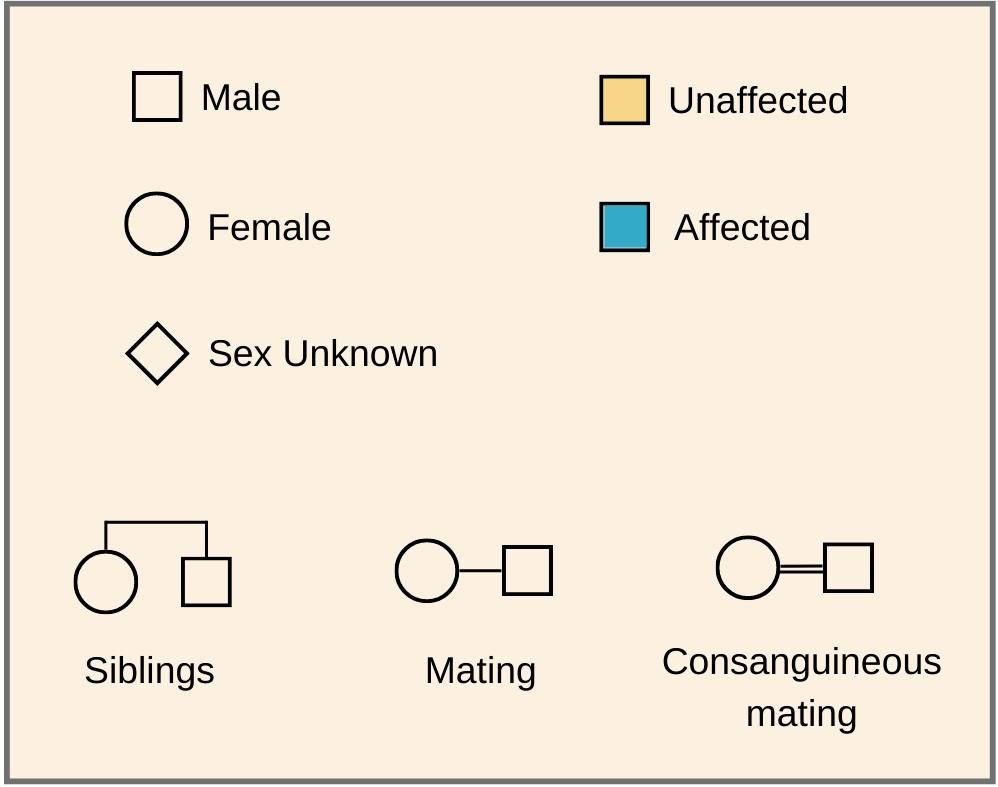
The affected individual that brings the family to the attention of a geneticist is called the proband. If an individual is known to have symptoms of the disease (affected), the symbol is filled in. Sometimes a half-filled-in symbol is used to indicate a known carrier of a disease; this is someone who does not have any symptoms of the disease but who passed the disease on to subsequent generations because they are a heterozygote. Note that when a pedigree is constructed, it is often unknown whether a particular individual is a carrier or not, so not all carriers are always explicitly indicated in a pedigree.
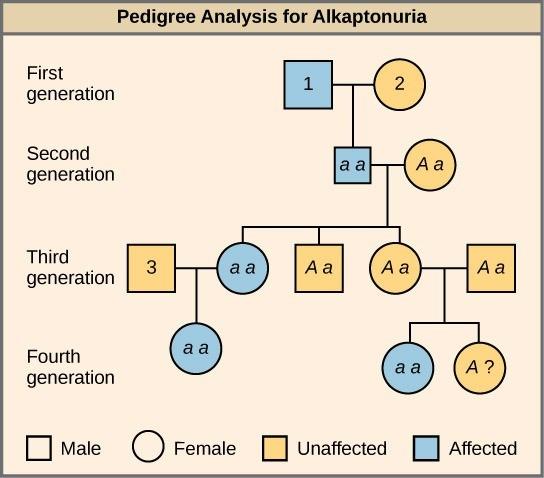
Reading Question #1
In a pedigree chart, what does a half-filled-in symbol represent?
A. An affected individual with symptoms of the disease.
B. An unaffected individual without any disease-causing allele.
C. An individual who is a known carrier of a disease.
D. An individual with an unknown genotype.
Reading Question #2
What is the purpose of pedigree analysis?
A. To determine the mode of inheritance of a genetic disease or trait.
B. To perform test crosses in humans to identify disease-causing genes.
C. To draw diagrams representing the phenotype and genotype of an organism.
D. To accurately track the family history of genetic diseases.
Inferring the Mode of Inheritance
Given a pedigree of an uncharacterized disease or trait, one of the first tasks is to determine which inheritance modes are possible and which mode of inheritance is most likely. This information is essential in calculating the probability that the trait will be inherited in any future offspring. We will mostly consider five major types of inheritance: autosomal dominant, autosomal recessive, X-linked dominant, X-linked recessive, and Y-linked.
Autosomal Dominant
When a dominant allele of a gene causes a disease, every person with that allele will show symptoms of the disease (assuming complete penetrance), and only one disease allele needs to be inherited for an individual to be affected. Thus, every affected individual must have an affected parent. A pedigree with affected individuals in every generation is typical of autosomal dominant diseases. However, beware that other modes of inheritance can also show the disease in every generation, as described below. It is also possible for an affected individual with an autosomal dominant disease to have a family without any affected children if the affected parent is a heterozygote. This is particularly true in small families, where the probability of every child inheriting the normal, rather than disease allele, is not extremely small. Note that autosomal dominant diseases are usually rare in populations; therefore, affected individuals with autosomal dominant diseases tend to be heterozygotes (otherwise, both parents would have had to be affected with the same rare disease). Achondroplastic dwarfism and polydactyly are examples of human conditions that may follow an autosomal dominant mode of inheritance.
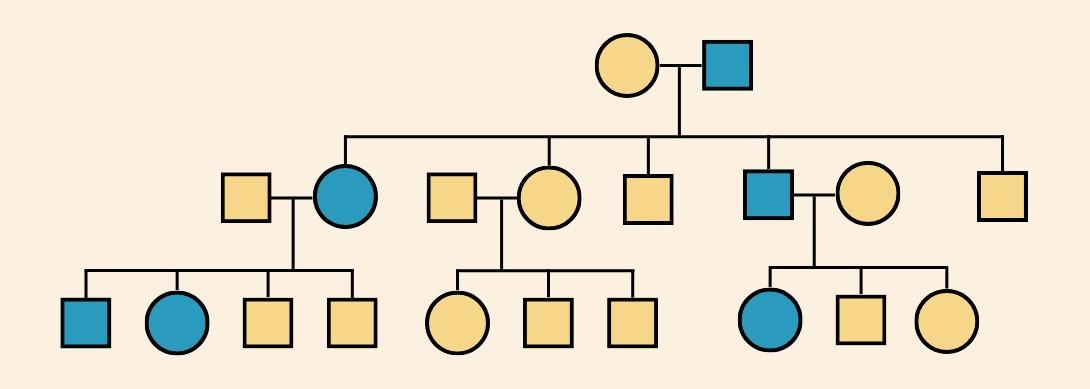
X-linked Dominant
In X-linked dominant inheritance, the gene responsible for the disease is located on the X-chromosome, and the allele that causes the disease is dominant to the normal allele in females. Because females have 2 X-chromosomes whereas males have only 1, females tend to be more frequently affected than males in the population. However, not all pedigrees provide sufficient information to distinguish x-linked dominant and autosomal dominant. One definitive indication that a trait is inherited as autosomal dominant and not X-linked dominant, is when an affected father passes the disease to a son. This type of transmission is not possible with X-linked dominant inheritance since males inherit their X chromosome from their mothers.
Autosomal Recessive
Diseases inherited in an autosomal recessive pattern require that both parents of an affected individual carry at least one copy of the recessive disease allele. With autosomal recessive traits, many individuals in a pedigree can be carriers, probably without knowing it. Compared to pedigrees of dominant traits, autosomal recessive pedigrees tend to show fewer affected individuals and are more likely than autosomal dominant or X-linked dominant to “skip a generation.” Thus, the major feature distinguishing autosomal recessive from dominant is that unaffected individuals can have affected offspring.
Many inborn errors of metabolism, such as phenylketonuria (PKU), are inherited as autosomal recessive. Newborns are often tested for a few of the most common metabolic diseases. A pedigree consistent with autosomal recessive inheritance is displayed in Figure 11.4 below.
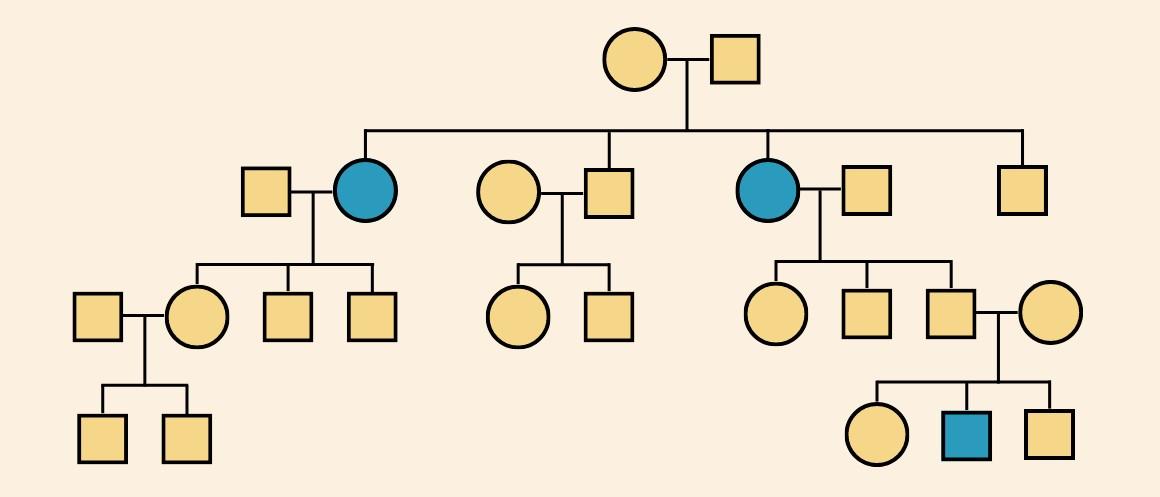
Everyday Connection: Carrier Screening
Carrier screening for autosomal recessive disorders is a “well-established public health measure that has substantially decreased the burden of a variety of diseases, particularly in individuals belonging to certain genetic risk groups or with a family history of genetic disease. Notable examples of the success of such screening programs when combined with pretest and posttest genetic counseling include the reduction of β-thalassemia cases in Greece and Italy by 80–90% and the diminishing of Tay–Sachs disease by ~90% in Ashkenazi Jews in the US and Israel” (Xiao & Lauschke, 2021).
As carrier screening methods improve, analyses of genetic disease structures in smaller geographic areas will be refined. This is important “for isolated populations, in which founder mutations can cause high population-specific prevalence of genetic conditions and diseases, as shown for Inuit, and Druze communities in Israel, and Dutch and Finnish populations. These founder mutations are often not covered in conventional testing panels and, consequently, members of these isolated populations might not optimally benefit from pan-ethnic risk variant profiling” (Xiao & Lauschke, 2021).
X-linked Recessive
Because males have only one X-chromosome, any male that inherits an X-linked recessive disease allele will be affected by it. Therefore, in X-linked recessive mode of inheritance, males tend to be affected more frequently than females in a population. This is in contrast to autosomal traits, where both sexes tend to be affected equally, and X-linked dominant, where females are affected more frequently. Note, however, in the small sample sizes typical of human families, it is usually not possible to accurately determine whether one sex is affected more frequently than others. On the other hand, one feature of a pedigree that can be used to definitively establish that an inheritance pattern is not X-linked recessive is the presence of an affected daughter from unaffected parents; because she would have had to inherit one X-chromosome from her father, he would also have been affected in X-linked recessive.
Some forms of color blindness are inherited as X-linked recessive traits. A pedigree consistent with X-linked recessive inheritance is displayed in Figure 11.5 below.
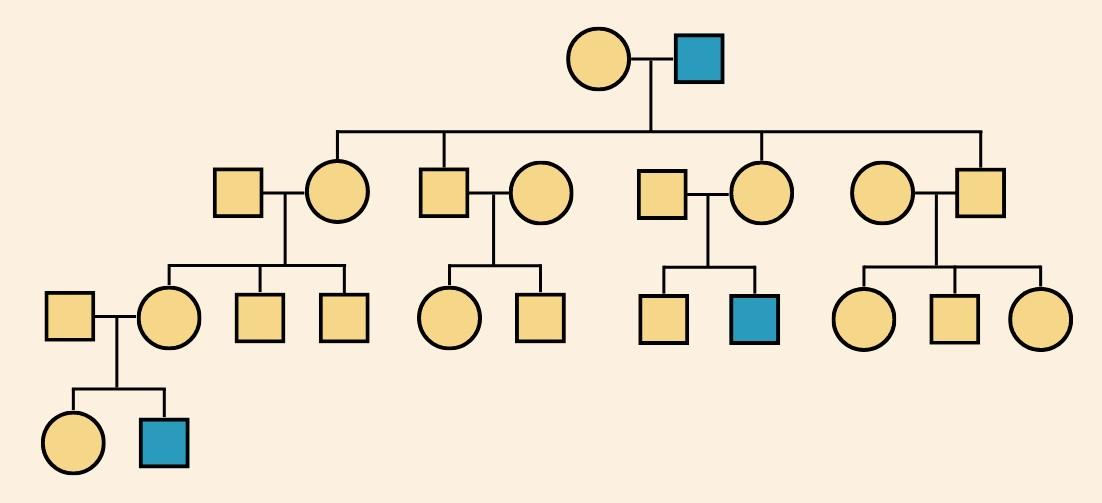
Y-linked and Mitochondrial Inheritance
Two additional modes are Y-linked and Mitochondrial inheritance.
Only males are affected in human Y-linked inheritance (and other species with the X/Y sex-determining system). There is only father-to-son transmission. This is the easiest mode of inheritance to identify, but it is one of the rarest because there are so few genes located on the Y-chromosome. An example of Y-linked inheritance is the hairy-ear-rim phenotype. As expected, this trait is passed on from father to all sons and no daughters. Y-chromosome DNA polymorphisms can be used to follow the male lineage in large families or through ancient ancestral lineages. For example, the Y-chromosome of Mongolian ruler Genghis Khan, and his male relatives, account for ~8% of the Y-chromosome lineage of men in Asia (0.5% worldwide).
Mutations in Mitochondrial DNA (mtDNA) are inherited through the maternal line. There are some human diseases associated with mutations in mitochondrial genes. These mutations can affect both males and females, but males cannot pass them on as the mitochondria are inherited via the egg, not the sperm. Mitochondrial DNA polymorphisms are also used to investigate evolutionary lineages, both ancient and recent. Because of the relative similarity of sequence, mtDNA is also used in species identification in ecology studies.
Reading Question #3
Which mode of inheritance is characterized by the presence of affected individuals in every generation?
A. Autosomal dominant
B. X-linked dominant
C. Autosomal recessive
D. X-linked recessive
Reading Question #4
Which mode of inheritance is characterized by the transmission of traits from fathers to all sons but no daughters?
A. Autosomal dominant
B. X-linked dominant
C. Autosomal recessive
D. Y-linked
Reading Question #5
A pedigree shows a disease that affects both males and females, with unaffected parents having affected offspring. Which mode of inheritance is most likely?
A) Autosomal dominant
B) X-linked dominant
C) Autosomal recessive
D) X-linked recessive
References and Acknowledgements
Xiao, Q. and Lauschke, V.M. (2021). The prevalence, genetic complexity, and population-specific founder effects of human autosomal recessive disorders. npj Genom. Med. 6(41). doi: 10.1038/s41525-021-00203-x
Adapted from Nickle T. and Barrette-Ng, I. (2022). 5: Pedigrees and Populations. Online Open Genetics. LibreTexts. Retrieved from https://bio.libretexts.org/Bookshelves/Genetics/Online_Open_Genetics_(Nickle_and_Barrette-Ng)/05%3A_Pedigrees_and_Populations

